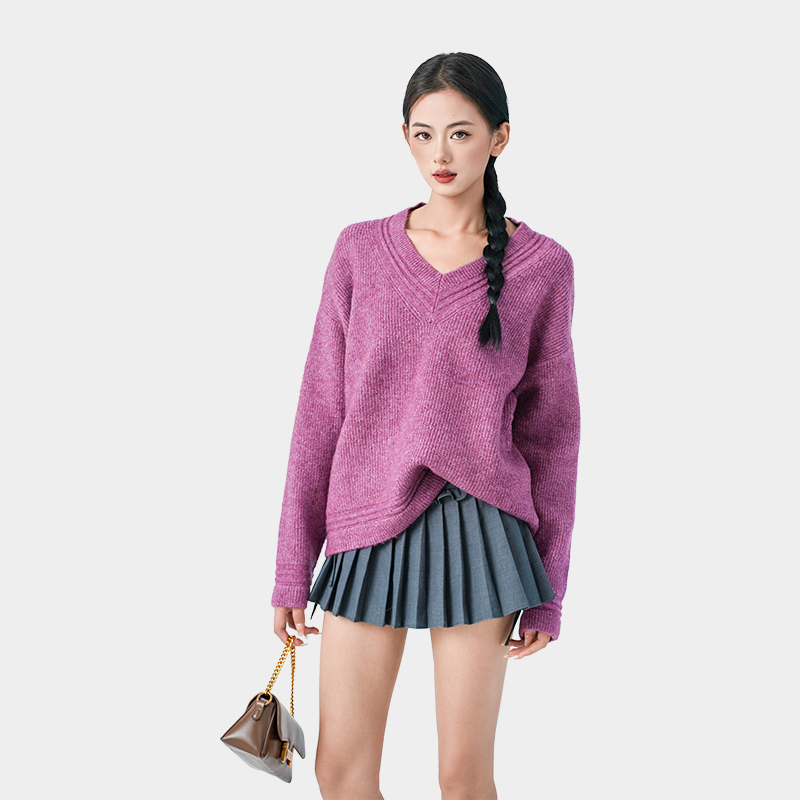What design techniques can be used to improve the areas of knitted pullovers that are prone to wear and tear?
Knitted pullovers, celebrated for their comfort, flexibility, and casual elegance, are foundational garments in many wardrobes. However, their stretch-based structure makes them inherently more vulnerable to wear, pilling, and deformation than woven counterparts. Certain areas, including the elbows, cuffs, underarms, side seams, and neckline, experience higher friction, tension, and repeated movement. For brands focused on quality and garment longevity, reinforcing these zones is essential.
1. Reinforced Stitch Construction
The choice of stitch and its density is central to a pullover’s mechanical strength. High-wear zones benefit from stitch techniques designed to minimize distortion and resist surface abrasion.
Ribbing for Edge Stability
1x1 or 2x2 rib knit is commonly used at cuffs, necklines, and waistbands to maintain elasticity and prevent curling.
Higher gauge ribbing improves edge recovery and resists bagging even after multiple washes.
Tighter Stitch Density in Stress Areas
In zones like elbows and underarms, increasing stitch density (more stitches per inch) creates a firmer, more durable fabric.
Stitch mapping in computerized knitting allows precise reinforcement without affecting overall fit.
Interlock or Double Knit Panels
Double-layer knits provide superior durability and structure compared to single jersey.
Strategic placement in areas like side seams, underarms, and shoulders can reduce abrasion and enhance shape retention.
2. Fiber and Yarn Selection for Strength and Resistance
While knit structure contributes to durability, the properties of the yarn used are equally critical.
Blended Yarns
Blends of cotton-polyester, wool-nylon, or acrylic-polyamide improve strength, abrasion resistance, and dimensional stability compared to single-fiber yarns.
Core-spun yarns, which use a strong filament core wrapped in softer fibers, combine resilience with comfort.
High-Twist Yarns
Using high-twist yarns in stress-prone zones adds tensile strength and reduces fuzz formation that leads to pilling.
These are especially useful in elbow or forearm sections where friction is frequent.
Compact or Combed Yarn Types
Yarns that undergo additional alignment (combing or compact spinning) have fewer protruding fibers, leading to smoother, more durable fabric surfaces.
3. Panel Engineering and Zoned Reinforcement
Modern knitwear production, particularly with flatbed and 3D knitting machines, allows for zoned construction — reinforcing specific garment areas without extra seams.
Integrated Elbow Patches
Using denser or double-knit areas in the elbow zones during knitting minimizes the need for additional sewing.
Textured stitches (e.g., moss stitch or tuck patterns) may be used to strengthen localized wear zones.
Shoulder and Neckline Stabilization
In high-tension zones such as shoulder seams, nylon or polyester reinforcement threads can be integrated into the knit to maintain shape and prevent stretching.
Necklines may benefit from taped shoulder seams or fully fashioned shaping to reduce distortion over time.
4. Construction Techniques That Reduce Stress
Beyond stitch and yarn choices, garment construction plays a pivotal role in reinforcing durability.
Fully Fashioned Knitting
Rather than cutting shapes from knit fabric, fully fashioned garments are knit to shape and assembled with fewer seams.
This eliminates raw edges and potential unraveling, especially around armholes and shoulders.
Seam Reinforcement
In sewn knit garments, flatlock seams or overlock stitching with reinforced backing tape add stretch-resilient strength.
For raglan or drop-shoulder designs, seamless integration helps reduce seam puckering and tearing under tension.

5. Post-Knitting Finishing Treatments
Proper finishing not only improves aesthetic appeal but also contributes to long-term durability.
Anti-Pilling Finishes
Applied chemically or mechanically, anti-pilling treatments reduce fiber breakage on the surface.
These are particularly effective for polyester- or acrylic-based pullovers.
Enzyme Washing for Natural Fibers
Enzyme washes help to reduce surface fuzz on cotton or wool knits, lowering the risk of pilling while preserving softness.
Heat Setting and Pre-Shrinking
For synthetic and blended yarns, heat setting stabilizes the fabric and improves resistance to shape distortion.
Pre-shrinking treatments ensure that reinforced zones maintain proportion after home laundering.
6. Design Features That Prevent Wear Concentration
Aesthetic and structural design also influence how stress is distributed throughout the garment.
Gussets and Articulated Seams
Underarm gussets or articulated elbow seams can redistribute movement tension and reduce local stress concentration.
These design elements also improve comfort and range of motion.
Pattern Placement
Cable knit or basket weave patterns add structural integrity in zones like the chest or upper back.
Alternating textured and flat zones help reduce friction buildup in high-contact areas.
7. User Education and Product Labeling
Lastly, even the most well-designed pullover will degrade faster if improperly cared for.
Care Instructions
Labels should include laundering tips that align with the fiber content and construction, such as drying flat to prevent stretch or using mesh laundry bags to reduce abrasion in machine washing.
User Guidance
Marketing materials can include notes about the pullover’s construction features, reinforcing perceived quality and encouraging appropriate usage.
Knitted pullovers combine comfort with versatility, but their inherent structure requires careful attention to durability in design and production. By integrating denser stitch constructions, strategic fiber blends, zoned reinforcements, and thoughtful garment construction, brands can significantly extend the wear life of these garments. These techniques not only add functional value but also enhance consumer satisfaction and brand reputation in a market that increasingly values quality and longevity.

 English
English 中文简体
中文简体 Español
Español












